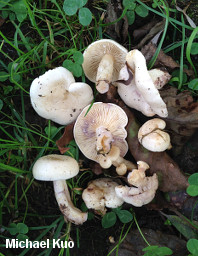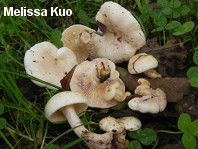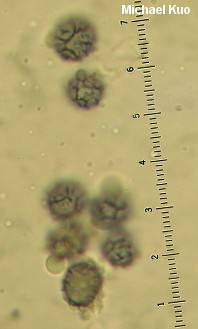| Major Groups > Gilled Mushrooms > Pale-Spored > Lactarius > Lactarius aspideus |

|
Lactarius aspideus [ Basidiomycota > Russulales > Russulaceae > Lactarius . . . ] by Michael Kuo One of many purple-staining milky caps, Lactarius aspideus can be recognized by its pale, whitish to yellowish colors and its association with European willows. It is reported to prefer wet, grassy areas, often near lakes (Heilmann-Clausen et al., 2000), and my collection, illustrated and described here, was made in just such a location in Italy's lake district. Similar European species can be separated on the basis of their mycorrhizal associations: Lactarius flavidus, in oak-beech-hornbeam ecosystems; and Lactarius salicis-herbaceae and Lactarius salicis-reticulatae, under dwarf willows in arctic and alpine ecosystems (the latter with reticulate spores). The name Lactarius aspideus has been applied in a few North American contexts (e.g. Smith, 1975), but the species probably does not occur on our continent. Lactarius aspideoides is a North American species first described from "a grassy place in hillside sheep-pasture near small fir trees" in Windham County, Vermont (Burlingham, 1907); its morphology is very similar, but it features a sticky stem surface and a bitter taste. Later North American authors have used the name aspideoides to apply to various morphologically similar collections across the continent, paying almost no attention whatsoever to the mycorrhizal tree associations and vastly different ecosystems; in short, contemporary study of this group, based on molecular and ecological data, will be required before any names can be applied with confidence. Description: Ecology: Mycorrhizal with willows, often in wet, grassy areas; growing alone, scattered, or gregariously; summer and fall; widely distributed in Europe, but not common. The illustrated and described collection is from Italy. Cap: 2.5–5 cm; convex at first, becoming more or less flat, or shallowly depressed; sticky when fresh but soon dry; bald; whitish to pale yellowish; not zoned; the margin not lined. Gills: Broadly attached to the stem or beginning to run down it; close; short-gills frequent; whitish to yellowish; stained lilac purple by the milk. Stem: 2–3 cm long; 0.5–1 cm thick; equal, or slightly tapered to the base; without potholes; bald; whitish to yellowish; staining lilac purple; fragile; hollowing. Flesh: Whitish; staining lilac when sliced. Milk: White; fairly copious; unchanging when exposed to air; staining tissues lilac purple. Odor and Taste: Not distinctive. Spore Print: Undocumented by me; reported as "pale cream" by Heilmann-Clausen et al. (2000). Microscopic Features: Spores 7–8 x 6–7 µm; broadly ellipsoid or subglobose; ornamented with amyloid warts and ridges extending 0.5–1 µm high; connectors fairly frequent, forming partial reticula. Macrocystidia narrowly fusiform; to about 65 x 10 µm. Pileipellis an ixocutis; elements 2.5–5 µm wide. REFERENCES: (Fries, 1818) Fries 1838. (Fries, 1821; Saccardo, 1887; Burlingham, 1907; Smith, 1975; Hesler & Smith, 1979; Phillips, 1981; Heilmann-Clausen et al., 2000; Kränzlin, 2005; Verbeken & Vesterholt, 2008.) Herb. Kuo 10161404. This site contains no information about the edibility or toxicity of mushrooms. |
© MushroomExpert.Com |
|
Cite this page as: Kuo, M. (2016, January). Lactarius aspideus. Retrieved from the MushroomExpert.Com Web site: http://www.mushroomexpert.com/lactarius_aspideus.html |


